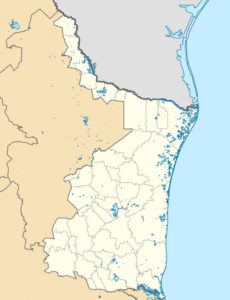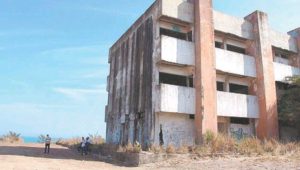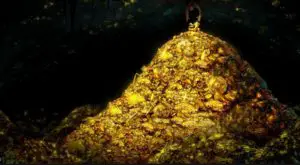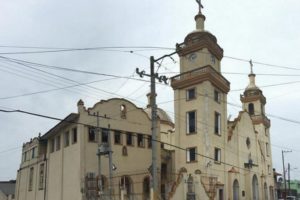Podcast: Play in new window | Download
Subscribe: Apple Podcasts | RSS
 The northern Mexican state of Tamaulipas hugs the Gulf of Mexico from Tampico to the international border and straddles the Rio Grande from Nuevo Laredo to Matamoros. It is home to beautiful mountains, sandy beaches, ample rivers and many interesting legends. Here are four.
The northern Mexican state of Tamaulipas hugs the Gulf of Mexico from Tampico to the international border and straddles the Rio Grande from Nuevo Laredo to Matamoros. It is home to beautiful mountains, sandy beaches, ample rivers and many interesting legends. Here are four.
- “La Planchada,” the Ghostly Nurse
Near Miramar Beach in the city of Ciudad Madero in the far southern extreme of the state of Tamaulipas, the Mexican government-owned oil monopoly, PEMEX, built a modern, cutting-edge hospital. The year was 1984. The hospital, which had sweeping views of the Gulf of Mexico, was rather large and was hailed as the most advanced in all Latin America. It was built primarily for oil workers and their families, but it was also open to the public. The name of the hospital was Centro de Rehabilitación Juan Álvarez Díaz and it was one of the prime places in all of Mexico for naturopathic medicine. A year after the hospital was built, a young and beautiful nurse fell in love with a handsome, but married, doctor. The doctor led the nurse along, toyed with her emotions, made her empty promises and then cut short their already brief affair. The nurse became terribly upset and sunk into a very deep depression. She could no longer function at her job and her co-workers noticed that she was making mistakes. The errors she made on the job were not mere mistakes, however. The nurse was so miserable she wanted to make others around her feel the same way and needed them to suffer along with her. In one instance, she withheld medication from a 9-year-old boy and the little boy died. The hospital conducted an investigation and found the nurse at fault for this little boy’s death along with the death of several other patients. The father of the murdered little boy arrived at the hospital one day bent on revenge. He found the nurse and killed her with a scalpel. This was not the only scandal at this  hospital. Once the pride of Mexico and known throughout the hemisphere for its use of advanced technology, the Hospital Juan Álvarez Díaz closed its doors just 5 years after its opening. Some residents of Ciudad Madero believed that the location itself was cursed and a hospital never should have been built on that site. Within a few years of its abandonment the medical center fell into disrepair and was taken over by the homeless and younger people who used the old hospital as a hang-out place or as a place to hold raves and after-hours parties. In 1994, a private security firm was hired to guard the property. It was in the 1990s that locals began telling stories of a ghost of a beautiful nurse seen roaming the ruins of that place, and it was then she earned the nickname “La Planchada.” Many people had accidents in the abandoned buildings and those unfortunate events were blamed on the menacing spirit of the nurse. By the early 2000s the former hospital became the site of satanic rituals, and police would find pentagrams drawn on the floors, blood on the walls and dead animals offered in sacrifice. It was as if evil itself became enhanced at this place. The hospital is now a shell of concrete covered in graffiti, overlooking the sea, with such a bad reputation that few dare go there.
hospital. Once the pride of Mexico and known throughout the hemisphere for its use of advanced technology, the Hospital Juan Álvarez Díaz closed its doors just 5 years after its opening. Some residents of Ciudad Madero believed that the location itself was cursed and a hospital never should have been built on that site. Within a few years of its abandonment the medical center fell into disrepair and was taken over by the homeless and younger people who used the old hospital as a hang-out place or as a place to hold raves and after-hours parties. In 1994, a private security firm was hired to guard the property. It was in the 1990s that locals began telling stories of a ghost of a beautiful nurse seen roaming the ruins of that place, and it was then she earned the nickname “La Planchada.” Many people had accidents in the abandoned buildings and those unfortunate events were blamed on the menacing spirit of the nurse. By the early 2000s the former hospital became the site of satanic rituals, and police would find pentagrams drawn on the floors, blood on the walls and dead animals offered in sacrifice. It was as if evil itself became enhanced at this place. The hospital is now a shell of concrete covered in graffiti, overlooking the sea, with such a bad reputation that few dare go there.
- Pancho Rojas and the Treasure of the Cerro Partido
 Sometime in the late 1800s in the southwestern part of the state of Tamaulipas, there lived a man named Pancho Rojas. He worked in the town of Ocampo so he would pass through the Cerro Partido riding his donkey on the way to work. One morning, the sun was already hot, so Pancho decided to find a large shade tree to rest under. As he was reclining under the tree, he remembered local legends of a vast Spanish treasure hidden somewhere in a cave in one of the hills. A few hundred years old, the fabled stash consisted of gemstones, gold Spanish doubloons and other riches. Motivated by this wild story, Pancho began to look around the hills. He soon stumbled across a series of small caves in a very remote area. He looked into one of the caves and saw the faint glimmer of shiny metal. Once inside the cave, to Pancho’s astonishment, he beheld wooden crates overflowing with gold coins and precious jewels. He stood there, amazed, trying to figure out how he would pack it all out of there on his donkey. As Pancho started to fill up a sack with some of the treasure, he heard a female voice whisper in his ear:
Sometime in the late 1800s in the southwestern part of the state of Tamaulipas, there lived a man named Pancho Rojas. He worked in the town of Ocampo so he would pass through the Cerro Partido riding his donkey on the way to work. One morning, the sun was already hot, so Pancho decided to find a large shade tree to rest under. As he was reclining under the tree, he remembered local legends of a vast Spanish treasure hidden somewhere in a cave in one of the hills. A few hundred years old, the fabled stash consisted of gemstones, gold Spanish doubloons and other riches. Motivated by this wild story, Pancho began to look around the hills. He soon stumbled across a series of small caves in a very remote area. He looked into one of the caves and saw the faint glimmer of shiny metal. Once inside the cave, to Pancho’s astonishment, he beheld wooden crates overflowing with gold coins and precious jewels. He stood there, amazed, trying to figure out how he would pack it all out of there on his donkey. As Pancho started to fill up a sack with some of the treasure, he heard a female voice whisper in his ear:
“You want the treasure, my son? It’s all or nothing, Panchito.”
 Scared, Pancho Rojas ran out of the cave with all the loot he could carry, packed it on his faithful donkey and headed back home. When he showed the riches to his family, they advised him to give half of the treasure to the Virgin of Contadero to ward off any evil spirits that may have been present in the cave. Pancho paid no mind to their advice and wanted to return to the Cerro Partido as soon as possible to retrieve more riches from the cave and to look for more in the other caves nearby. Before planning his next trip into the hills, Pancho decided to go on a spending spree with some of the old Spanish coins. When he passed by the shrine to the Virgin of Contadero, he remembered what members of his family said, but kept on going, not even stopping to acknowledge the Blessed Mother. When Pancho opened the sack at the first store at which he was to make a large purchase, he saw that all the treasure had turned to stone. While he couldn’t explain what had happened, Pancho knew all he had to do was return to the Cerro Partido and find the caves again because there was a lot more treasure there waiting for him to take away. So, he mounted his donkey, headed for the hills, and hoped for the best. When he arrived at the spot where he had rested under the tree on that hot day a few days earlier, he could not find the caves. According to the story, a shadow of an old indigenous woman appeared in front of him and whispered in the same voice he had heard when he was in the treasure cave.
Scared, Pancho Rojas ran out of the cave with all the loot he could carry, packed it on his faithful donkey and headed back home. When he showed the riches to his family, they advised him to give half of the treasure to the Virgin of Contadero to ward off any evil spirits that may have been present in the cave. Pancho paid no mind to their advice and wanted to return to the Cerro Partido as soon as possible to retrieve more riches from the cave and to look for more in the other caves nearby. Before planning his next trip into the hills, Pancho decided to go on a spending spree with some of the old Spanish coins. When he passed by the shrine to the Virgin of Contadero, he remembered what members of his family said, but kept on going, not even stopping to acknowledge the Blessed Mother. When Pancho opened the sack at the first store at which he was to make a large purchase, he saw that all the treasure had turned to stone. While he couldn’t explain what had happened, Pancho knew all he had to do was return to the Cerro Partido and find the caves again because there was a lot more treasure there waiting for him to take away. So, he mounted his donkey, headed for the hills, and hoped for the best. When he arrived at the spot where he had rested under the tree on that hot day a few days earlier, he could not find the caves. According to the story, a shadow of an old indigenous woman appeared in front of him and whispered in the same voice he had heard when he was in the treasure cave.
“All or nothing, Panchito.”
Overcome with fright and exhausted from the search, Pancho Rojas collapsed and died on the spot. To this day, according to locals, when the light is just right at sundown, you can see the silhouette of Pancho and his donkey on the side of the Cerro Partido, and that serves as a reminder to all those who see it that greed does not pay.
- The Vampire Woman of San Juan Bosco Church
In the city of Ciudad Madero, Father Ignacio Rosiles, dedicated his body and soul to the rehabilitation of the old church of San Juan Bosco. Through his tireless campaign to raise funds for renovations and repairs, he received the support of the wife of the superintendent of the local oil refinery who was from a well-to-do Tamaulipas family. The benefactress always told the priest that the day she died she wanted her remains to rest in the San Juan Bosco Church where she tirelessly dedicated the time that she had left over from the work of being a mother and wife. Over the years, the woman’s two children grew up and became great professionals and moved to the town of Salamanca in the state of Guanajuato. When their mother got on in years, they brought the distinguished woman to live with them, until she died of old age in 1973. She was buried in a cemetery in Salamanca.
 A few years later, the priest at the San Juan Bosco Church, a man named Father Namorado, found out about the woman’s death. He had remembered her last wishes as told to him by the previous priest, Father Ignacio. Father Namorado decided to reach out to the relatives of the woman and asked for their approval to exhume her body and transfer it to the San Juan Bosco Church in Ciudad Madero where the noble benefactress would rest for all eternity. The family granted permission and cemetery workers dug up the woman’s coffin. When they opened it up, they were surprised to find the body uncorrupted and perfectly preserved except for the woman’s fingernails and teeth which had grown to twice their normal length. Although a few people were witness to this, the rumors arrived with the woman’s body to Ciudad Madero and soon wild stories began to circulate in the Arbol Grande neighborhood surrounding the Church of San Juan Bosco. The nickname of this once noble benefactress became “The Vampire Woman,” and people on different occasions claimed to have seen her fly from the church heading either for the beach or for the cathedral at nearby Tampico. Stories began to circulate about “The Vampire Woman” attacking children or going after neighborhood dogs. At one point, the fear and anger of the people of the Arbol Grande neighborhood was so intense that some threatened to burn down the church to rid the community of this hideous evil spirit. Local politicians even called in the Mexican army to try to prevent civil unrest. When locals were told by church officials that the body of the benefactress would be returned to Salamanca, sightings of the famous “Vampire Woman” suddenly stopped. It is unknown whether the body of the woman was even moved. Some say she still rests in a small vault underneath the Church of San Juan Bosco or was laid rest in the adjacent Arbol Grande Cemetery.
A few years later, the priest at the San Juan Bosco Church, a man named Father Namorado, found out about the woman’s death. He had remembered her last wishes as told to him by the previous priest, Father Ignacio. Father Namorado decided to reach out to the relatives of the woman and asked for their approval to exhume her body and transfer it to the San Juan Bosco Church in Ciudad Madero where the noble benefactress would rest for all eternity. The family granted permission and cemetery workers dug up the woman’s coffin. When they opened it up, they were surprised to find the body uncorrupted and perfectly preserved except for the woman’s fingernails and teeth which had grown to twice their normal length. Although a few people were witness to this, the rumors arrived with the woman’s body to Ciudad Madero and soon wild stories began to circulate in the Arbol Grande neighborhood surrounding the Church of San Juan Bosco. The nickname of this once noble benefactress became “The Vampire Woman,” and people on different occasions claimed to have seen her fly from the church heading either for the beach or for the cathedral at nearby Tampico. Stories began to circulate about “The Vampire Woman” attacking children or going after neighborhood dogs. At one point, the fear and anger of the people of the Arbol Grande neighborhood was so intense that some threatened to burn down the church to rid the community of this hideous evil spirit. Local politicians even called in the Mexican army to try to prevent civil unrest. When locals were told by church officials that the body of the benefactress would be returned to Salamanca, sightings of the famous “Vampire Woman” suddenly stopped. It is unknown whether the body of the woman was even moved. Some say she still rests in a small vault underneath the Church of San Juan Bosco or was laid rest in the adjacent Arbol Grande Cemetery.
- The Hair-Pulling Phantom of Reynosa
 In the early 1800s, when Spain still ruled the Rio Grande valley, the Tamaulipas border city of Reynosa was a sleepy backwater outpost. A wealthy Spanish settler in this tiny town named Don Arcadio Cantú built an impressive two-story building to house businesses and residences. As Reynosa grew Cantú began constructing more buildings and had his eyes on surrounding lands on which he wanted to create a large ranch. The territory was still somewhat unsettled at the time and Don Arcadio had run-ins with the local indigenous people who the Spanish referred to as the Tareguana tribe. No one today knows anything about this native group. Tired of being harassed by the Spanish, a Tareguana youth challenged Don Arcadio Cantú to a fight to the death. Cantú accepted the challenge but lost the fight and the victor cut off the scalp of the Spanish man as a trophy. Many decades after Cantú’s his death, the town of Reynosa grew and the beautiful two-story building Don Arcadio had constructed was torn down. During the clean-up after the building’s demolition, human bones were found on the property. This sparked rumors that the site was haunted because it was a place where great evil took place, although there was no formal explanation as to why the bones were there. On the site a new building was built and housed different businesses over the years. Many people visiting the businesses have claimed that they feel someone or something tugging at their hair. Some believe it is the ghost of Don Arcadio Cantú seeking to do to someone else what was done to him after his death. Others believe it is a ghost of a Tareguana looking for more scalps in an attempt to try to scare away the foreign invaders after many centuries of occupation of Tareguana lands. In any case, to the visitor of this border city, beware of the hair-pulling ghost of Reynosa. If you have any hair, that is.
In the early 1800s, when Spain still ruled the Rio Grande valley, the Tamaulipas border city of Reynosa was a sleepy backwater outpost. A wealthy Spanish settler in this tiny town named Don Arcadio Cantú built an impressive two-story building to house businesses and residences. As Reynosa grew Cantú began constructing more buildings and had his eyes on surrounding lands on which he wanted to create a large ranch. The territory was still somewhat unsettled at the time and Don Arcadio had run-ins with the local indigenous people who the Spanish referred to as the Tareguana tribe. No one today knows anything about this native group. Tired of being harassed by the Spanish, a Tareguana youth challenged Don Arcadio Cantú to a fight to the death. Cantú accepted the challenge but lost the fight and the victor cut off the scalp of the Spanish man as a trophy. Many decades after Cantú’s his death, the town of Reynosa grew and the beautiful two-story building Don Arcadio had constructed was torn down. During the clean-up after the building’s demolition, human bones were found on the property. This sparked rumors that the site was haunted because it was a place where great evil took place, although there was no formal explanation as to why the bones were there. On the site a new building was built and housed different businesses over the years. Many people visiting the businesses have claimed that they feel someone or something tugging at their hair. Some believe it is the ghost of Don Arcadio Cantú seeking to do to someone else what was done to him after his death. Others believe it is a ghost of a Tareguana looking for more scalps in an attempt to try to scare away the foreign invaders after many centuries of occupation of Tareguana lands. In any case, to the visitor of this border city, beware of the hair-pulling ghost of Reynosa. If you have any hair, that is.
REFERENCES
Many thinks to the publication Milenio for sharing these stories with me.
